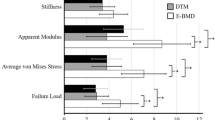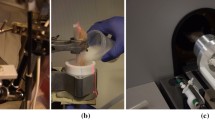Abstract
Summary
Despite an increasing use of high-resolution peripheral quantitative computed tomography (HR-pQCT) to evaluate bone morphology in vivo, there are reservations about its applicability in patients with osteoporosis and antiresorptive therapy. This study shows that HR-pQCT provides acceptable in vivo accuracy for bone volume fraction (BV/TV) in patients with osteoporosis and bisphosphonate (BP) treatment.
Introduction
The primary aim was to analyze agreement of trabecular structure between HR-pQCT and gold standard microtomography (μCT) in patients with osteoporosis and long-term BP therapy.
Methods
In the BioAsset study, we analyzed cadaver radii and tibiae of 34 postmenopausal females (81.1 ± 7.1 years) with osteoporosis (no BP n = 22, 1–5 years BP n = 5, >5 years BP n = 7). Two HR-pQCT protocols (patient-mode and μCT-mode) were compared with gold standard μCT after image registration. Undecalcified histological sections were obtained to quantify nonmineralized bone matrix. Bland-Altman plots illustrated methodological agreement. Multiple regression analysis was used to test for variables associated with method agreement.
Results
In the radius and tibia, patient-mode HR-pQCT derived indices including bone volume fraction, trabecular number, and trabecular separation correlated well with gold standard μCT (R 2 = 0.78 − 0.88) except for trabecular thickness (R 2 = 0.11). Bland-Altman plots illustrated adequate agreement for bone volume fraction. Lower agreement of trabecular number and trabecular separation improved with decreasing structural impairment at the tibia only. Trabecular thickness was not appropriately assessed with HR-pQCT at both skeletal sites. Higher agreement for bone volume fraction was associated with increasing tissue mineral density in the tibia.
Conclusions
HR-pQCT provides acceptable in vivo accuracy for BV/TV in patients with osteoporosis and BP treatment. Higher TMD was associated with higher BV/TV accuracy in vivo. Overall, methodological agreement got less accurate with increasing structural impairment in the tibia.




Similar content being viewed by others
References
Cummings SR, Nevitt MC, Browner WS, Stone K, Fox KM, Ensrud KE, Cauley J, Black D, Vogt TM (1995) Risk factors for hip fracture in white women. Study of Osteoporotic Fractures Research Group. N Engl J Med 332(12):767–773. doi:10.1056/NEJM199503233321202
Rodan GA, Reszka AA (2003) Osteoporosis and bisphosphonates. J Bone Jt Surg Am 85-A (Suppl 3):8–12
Consensus development conference: diagnosis, prophylaxis, and treatment of osteoporosis (1993) Am J Med 94(6):646–50
Ammann P, Rizzoli R (2003) Bone strength and its determinants. Osteoporos Int 14(Suppl 3):S13–18. doi:10.1007/s00198-002-1345-4
Schuit SC, van der Klift M, Weel AE, de Laet CE, Burger H, Seeman E, Hofman A, Uitterlinden AG, van Leeuwen JP, Pols HA (2004) Fracture incidence and association with bone mineral density in elderly men and women: the Rotterdam Study. Bone 34(1):195–202
Boutroy S, Van Rietbergen B, Sornay-Rendu E, Munoz F, Bouxsein ML, Delmas PD (2008) Finite element analysis based on in vivo HR-pQCT images of the distal radius is associated with wrist fracture in postmenopausal women. J Bone Miner Res 23(3):392–399. doi:10.1359/jbmr.071108
Nishiyama KK, Macdonald HM, Hanley DA, Boyd SK (2013) Women with previous fragility fractures can be classified based on bone microarchitecture and finite element analysis measured with HR-pQCT. Osteoporos Int 24(5):1733–1740. doi:10.1007/s00198-012-2160-1
Sornay-Rendu E, Boutroy S, Munoz F, Delmas PD (2007) Alterations of cortical and trabecular architecture are associated with fractures in postmenopausal women, partially independent of decreased BMD measured by DXA: the OFELY study. J Bone Miner Res 22(3):425–433. doi:10.1359/jbmr.061206
MacNeil JA, Boyd SK (2008) Improved reproducibility of high-resolution peripheral quantitative computed tomography for measurement of bone quality. Med Eng Phys 30(6):792–799. doi:10.1016/j.medengphy.2007.11.003
Burghardt AJ, Kazakia GJ, Majumdar S (2007) A local adaptive threshold strategy for high resolution peripheral quantitative computed tomography of trabecular bone. Ann Biomed Eng 35(10):1678–1686. doi:10.1007/s10439-007-9344-4
Liu XS, Zhang XH, Sekhon KK, Adams MF, McMahon DJ, Bilezikian JP, Shane E, Guo XE (2010) High-resolution peripheral quantitative computed tomography can assess microstructural and mechanical properties of human distal tibial bone. J Bone Miner Res 25(4):746–756. doi:10.1359/jbmr.090822
Sekhon K, Kazakia GJ, Burghardt AJ, Hermannsson B, Majumdar S (2009) Accuracy of volumetric bone mineral density measurement in high-resolution peripheral quantitative computed tomography. Bone 45(3):473–479. doi:10.1016/j.bone.2009.05.023
Boivin GY, Chavassieux PM, Santora AC, Yates J, Meunier PJ (2000) Alendronate increases bone strength by increasing the mean degree of mineralization of bone tissue in osteoporotic women. Bone 27(5):687–694
Busse B, Hahn M, Soltau M, Zustin J, Puschel K, Duda GN, Amling M (2009) Increased calcium content and inhomogeneity of mineralization render bone toughness in osteoporosis: mineralization, morphology and biomechanics of human single trabeculae. Bone 45(6):1034–1043. doi:10.1016/j.bone.2009.08.002
Ibanez L, Schroeder W, Ng L, Cates J (2005) The ITK Software Guide.
Museyko O, Eisa F, Hess A, Schett G, Kalender WA, Engelke K (2010) Binary segmentation masks can improve intrasubject registration accuracy of bone structures in CT images. Ann Biomed Eng 38(7):2464–2472. doi:10.1007/s10439-010-9981-x
Hahn M, Vogel M, Delling G (1991) Undecalcified preparation of bone tissue: report of technical experience and development of new methods. Virchows Arch A, Pathological Anat histopathol 418(1):1–7
Krause M, Breer S, Hahn M, Ruther W, Morlock MM, Amling M, Zustin J (2012) Cementation and interface analysis of early failure cases after hip-resurfacing arthroplasty. Int Orthop 36(7):1333–1340. doi:10.1007/s00264-011-1464-7
Krause M, Rupprecht M, Mumme M, Puschel K, Amling M, Barvencik F (2013) Bone Microarchitecture of the Talus Changes With Aging. Clin Orthop Relat Res. doi:10.1007/s11999-013-3195-0
Dempster DW, Compston JE, Drezner MK, Glorieux FH, Kanis JA, Malluche H, Meunier PJ, Ott SM, Recker RR, Parfitt AM (2013) Standardized nomenclature, symbols, and units for bone histomorphometry: a 2012 update of the report of the ASBMR Histomorphometry Nomenclature Committee. J Bone Miner Res 28(1):2–17. doi:10.1002/jbmr.1805
MacNeil JA, Boyd SK (2007) Accuracy of high-resolution peripheral quantitative computed tomography for measurement of bone quality. Med Eng Phys 29(10):1096–1105. doi:10.1016/J.Medengphy.2006.11.002
Hildebrand T, Ruegsegger P (1997) A new method for the model-independent assessment of thickness in three-dimensional images. J Microsc-Oxford 185:67–75
Parfitt AM, Mathews CH, Villanueva AR, Kleerekoper M, Frame B, Rao DS (1983) Relationships between surface, volume, and thickness of iliac trabecular bone in aging and in osteoporosis. Implications for the microanatomic and cellular mechanisms of bone loss. J Clin Invest 72(4):1396–1409. doi:10.1172/JCI111096
Burghardt AJ, Kazakia GJ, Laib A, Majumdar S (2008) Quantitative assessment of bone tissue mineralization with polychromatic micro-computed tomography. Calcif Tissue Int 83(2):129–138. doi:10.1007/s00223-008-9158-x
Mulder L, Koolstra JH, Van Eijden TM (2004) Accuracy of microCT in the quantitative determination of the degree and distribution of mineralization in developing bone. Acta Radiol 45(7):769–777
Bland JM, Altman DG (1995) Comparing methods of measurement: why plotting difference against standard method is misleading. Lancet 346(8982):1085–1087
Bland JM, Altman DG (2012) Agreed statistics: measurement method comparison. Anesthesiology 116(1):182–185. doi:10.1097/ALN.0b013e31823d7784
Bland JM, Altman DG (1999) Measuring agreement in method comparison studies. Stat Methods Med Res 8(2):135–160
Priemel M, von Domarus C, Klatte TO, Kessler S, Schlie J, Meier S, Proksch N, Pastor F, Netter C, Streichert T, Puschel K, Amling M (2010) Bone mineralization defects and vitamin D deficiency: histomorphometric analysis of iliac crest bone biopsies and circulating 25-hydroxyvitamin D in 675 patients. J Bone Miner Res 25(2):305–312. doi:10.1359/jbmr.090728
Bernhard A, Milovanovic P, Zimmermann EA, Hahn M, Djonic D, Krause M, Breer S, Puschel K, Djuric M, Amling M, Busse B (2013) Micro-morphological properties of osteons reveal changes in cortical bone stability during aging, osteoporosis, and bisphosphonate treatment in women. Osteoporos Int 24(10):2671–2680. doi:10.1007/s00198-013-2374-x
Roschger P, Lombardi A, Misof BM, Maier G, Fratzl-Zelman N, Fratzl P, Klaushofer K (2010) Mineralization density distribution of postmenopausal osteoporotic bone is restored to normal after long-term alendronate treatment: qBEI and sSAXS data from the fracture intervention trial long-term extension (FLEX). J Bone Miner Res 25(1):48–55. doi:10.1359/jbmr.090702
Zebaze RM, Ghasem-Zadeh A, Bohte A, Iuliano-Burns S, Mirams M, Price RI, Mackie EJ, Seeman E (2010) Intracortical remodelling and porosity in the distal radius and post-mortem femurs of women: a cross-sectional study. Lancet 375(9727):1729–1736. doi:10.1016/S0140-6736(10)60320-0
MacNeil JA, Boyd SK (2007) Load distribution and the predictive power of morphological indices in the distal radius and tibia by high resolution peripheral quantitative computed tomography. Bone 41(1):129–137. doi:10.1016/j.bone.2007.02.029
Laib A, Ruegsegger P (1999) Calibration of trabecular bone structure measurements of in vivo three-dimensional peripheral quantitative computed tomography with 28-microm-resolution microcomputed tomography. Bone 24(1):35–39
Fuchs RK, Shea M, Durski SL, Winters-Stone KM, Widrick J, Snow CM (2007) Individual and combined effects of exercise and alendronate on bone mass and strength in ovariectomized rats. Bone 41(2):290–296. doi:10.1016/j.bone.2007.04.179
Allen MR, Kubek DJ, Burr DB (2010) Cancer treatment dosing regimens of zoledronic acid result in near-complete suppression of mandible intracortical bone remodeling in beagle dogs. J Bone Miner Res 25(1):98–105. doi:10.1359/jbmr.090713
Smith SY, Recker RR, Hannan M, Muller R, Bauss F (2003) Intermittent intravenous administration of the bisphosphonate ibandronate prevents bone loss and maintains bone strength and quality in ovariectomized cynomolgus monkeys. Bone 32(1):45–55
Pialat JB, Burghardt AJ, Sode M, Link TM, Majumdar S (2012) Visual grading of motion induced image degradation in high resolution peripheral computed tomography: impact of image quality on measures of bone density and micro-architecture. Bone 50(1):111–118. doi:10.1016/j.bone.2011.10.003
Borah B, Dufresne T, Nurre J, Phipps R, Chmielewski P, Wagner L, Lundy M, Bouxsein M, Zebaze R, Seeman E (2010) Risedronate reduces intracortical porosity in women with osteoporosis. J Bone Miner Res 25(1):41–47. doi:10.1359/jbmr.090711
Acknowledgment
This project was supported by the German Federal Ministry of Education and Research by the grant “BMBF, BioAsset 01EC1005D” to MA, KP, KE and CCG and by the grant “BMBF, Osteopath 01 EC 1006” to MA.
Conflicts of interest
None.
Author information
Authors and Affiliations
Corresponding author
Additional information
M. Krause, O. Museyko, and S. Breer contributed equally to the manuscript and therefore share first authorship.
Rights and permissions
About this article
Cite this article
Krause, M., Museyko, O., Breer, S. et al. Accuracy of trabecular structure by HR-pQCT compared to gold standard μCT in the radius and tibia of patients with osteoporosis and long-term bisphosphonate therapy. Osteoporos Int 25, 1595–1606 (2014). https://doi.org/10.1007/s00198-014-2650-4
Received:
Accepted:
Published:
Issue Date:
DOI: https://doi.org/10.1007/s00198-014-2650-4




